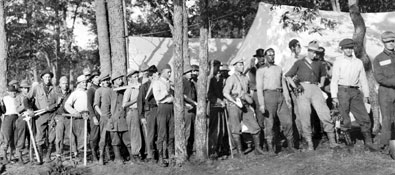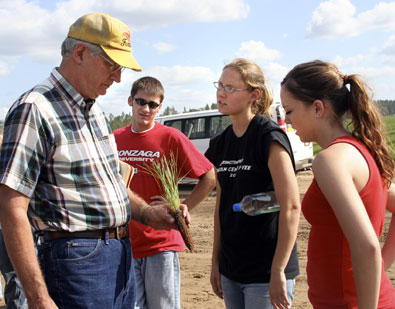Inside Iowa State
Inside ArchivesSubmit newsSend news for Inside to inside@iastate.edu, or call (515) 294-7065. See publication dates, deadlines. About InsideInside Iowa State, a newspaper for faculty and staff, is published by the Office of University Relations. |
Nov. 16, 2007 
Members of Iowa State's first forestry camp in 1914. Courtesy of Natural Resource Ecology and Management Archives. Classroom in the treesby Barbara McBreen, Agriculture and Life Sciences Communications Visiting a nursery with 26 million 6-inch pine trees, touching a 400-year-old tree, learning about pine cone harvesting, walking barefoot on a seashore in a national park and watching particleboard slide down a factory assembly line -- that's a few of the things students did at this year's forestry camp in October. For 90 years, Iowa State faculty have taken forestry students to every region in the United States to explore the varied branches of forestry. "We want to get them out where forestry is a big part of the economy. Where they can see all the gradations of forestry and they can make informed decisions about what type of forestry they want to pursue," said Steve Jungst, Iowa State Harmon Family Professor in Forestry in the natural resource ecology and management department. Jungst and Jan Thompson, associate professor in natural resource ecology and management, were the faculty in charge of 22 students who attended this year's three-week camp based at the Solon Dixon Forestry Education Center near Andalusia, Ala. The campus, which is surrounded by 5,350 acres of forestland, resembles a hunting lodge. "I like being in the middle of nowhere," said Zach Keninger, a junior in forestry from Newton. "The longleaf pine ecosystem is pretty cool. We saw a remnant of that ecosystem at Eglin Air Force Base. The trees were 400 years old and 60 to 70 feet tall." In the beginningIowa State's first forestry camp, a three-month summer experience, was held at Cass Island, Minn., in 1914. Since then, students have gone to camp annually, except during war years. In 1918, students contributed 12 weeks of production war work at a lumber company in Wauna, Ore., instead of going to camp. The camp also was suspended from 1943 to 1945 due to low enrollments during World War II. In 1915, and for the next 80 years, the camp was shortened from 10 weeks to six weeks to fit students' schedules. In 1994, the camp was shortened to three weeks and moved to the fall. The fall curriculum is offered to sophomores to allow students to get early field experience. "Some of the students go to camp and figure out that forestry isn't what they want to do -- and that's important," Jungst said. We want youThe camp experience includes industry tours that break down the stereotype that forestry majors only become park rangers. Jungst said students can take options in forest ecosystem management, urban and community forestry, natural resource conservation and restoration, interpretation, and sustainable materials science. They learn about controlled burns, thinning, stocking and tree management. The message students heard over and over at this fall's camp: We have openings and we want you. College of Agriculture and Life Sciences career services office data indicates that 94 percent of forestry graduates from 2005-06 were placed in jobs or continued their educations. "The Florida Division of Forestry folks were giving a hard sell, telling students to come down there and work because they need foresters. And we saw the same thing with the folks at Temple Inland on the products side," Jungst said. "We don't have to work very hard selling students on jobs because the people we visit do it for us." The camp also is an important experience for faculty. Thompson said it's fun to see students analyze the area and the ecosystems, and figure out what they want to do. "It really comes alive at camp because they are talking with the actual practitioners who are eager to share," Thompson said. "I've seen students on these tours and all of the sudden a light goes on and they decide this is what they want to do -- and that's fun to watch." Bryan Ott was one of those students. He was surprised by what he learned from the urban forester in Mobile. Ott, a sophomore in forestry from Elkader, said both his parents graduated with degrees in forestry but he hadn't thought about the urban forestry option. "It really opened my eyes about how to manage trees within a city. It's all about saving the trees because it's part of their history," Ott said. The ties that bindAt camp, students learn to relate with peers and faculty. "We have this common experience," Jungst said. "I know them better and I know how they operate and what motivates them, and that's all very helpful." That sense of community formed during camp is a root connection between graduates. Jungst said one year a student had his picture taken at every state welcome sign on the way to Alabama because he had never been out of Iowa. "It's a common bond among all Iowa State foresters," Jungst said. "This group can go to the national conference and attend the alumni event and the first thing they will talk about is going to forestry camp. "It's a bonding experience that other graduates don't have." |

Forestry professor Steve Jungst (left) and ISU sophomore forestry students look over a longleaf pine tree during their three-week camp experience in Alabama last month. Photo by Barbara McBreen. Quote" . . . and all of the sudden a light goes on and they decide this is what they want to do - and that's fun to watch." Jan Thompson |